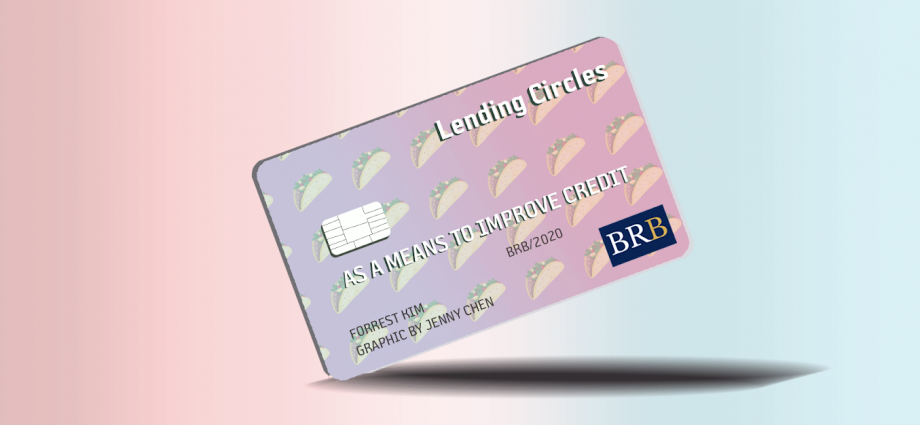Author: Forrest Kim, Graphics: Jenny Chen
The BRB Bottomline: essentially, lending circles act as zero-interest loans and gives subprime borrowers an option to practice and prove financial responsibility – if payments are met on time. The beauty of the lending circle is its accessibility…Lending Circles offer subprime borrowers and the credit invisible an option where there are few.
To say that my AP Economics teacher had a credit card dedicated to burritos when he was in college is slightly misleading. While it’s true that he solely bought burritos on that credit card, the object of his purchase was arbitrary. Whether he bought burritos or tacos, either way my AP Economics teacher would have learned good borrowing practices and bolstered his credit score through the process of borrowing money and paying it back.
Unfortunately, many other people are not as financially savvy as my AP Economics teacher was in college. Approximately 51% of credit scores are subprime and nearly one in five consumers don’t have a credit score at all. Credit invisibility and subprime credit bring a host of problems; it could mean the difference between being able to secure crucial contracts like leases, auto loans, and mortgages or not. In some states, employers are even taking account of credit score when determining employee candidacy. It’s clear that living without good credit takes a huge toll on one’s quality of life.
Building Credit Score is Very Difficult
While it’s obvious that subprime credit is detrimental, why do people struggle to raise it? Improving credit can be incredibly difficult because subprime credit and credit invisibility often yields high interest loans or outright denial. To hedge against the risk of loan default, creditors will often only offer high interest loans (which are harder to pay back) to those with bad credit. After all, according to their credit scores, subprime borrowers are more susceptible in defaulting and not paying back their debt. A cycle emerges where subprime borrowers can only take out high interest loans, making them more likely to default and worsen their credit.
Subprime credit and credit invisibility create a catch-22. In order to improve their credit score, people need affordable loans which are usually only given to those with good credit.
Lending Circles as a Solution
Lending circles, however, offer an opportunity to break from the bad credit cycle. They are utilized all around the world, typically by people in developing countries and by immigrants who may not have access to resources offered by formal financial institutions. They take on a variety of names: tanda (Latin America), Kye (South Korea), chama (Swahili-speaking East Africa), and more formally, rotating savings and credit association. Lending circles are currently offered in the United States by many credit unions as a financial option to help those with bad credit or credit invisibility.
They offer a clever, easy way to borrow money and pay it back. As an example, say there are five people. Every month, each of these ten people put one hundred dollars into a pool. One person takes home the pool of five hundred dollars each month and this process repeats until everyone has taken home their sum of money. So by the fifth month, everyone will have received the pool and will have paid into it five times. Every transaction made within the lending circle is then reported to a credit bureau.
Essentially, lending circles act as zero-interest loans and gives subprime borrowers an option to practice and prove financial responsibility – if payments are met on time. The beauty of the lending circle is its accessibility; local nonprofit Mission Asset Fund lists a source of income and a manageable debt as the only eligibility requirements. Lending Circles offer subprime borrowers and the credit invisible an option where there are few.
In Practice
Zero-interest loans being available to virtually anyone might sound too good to be true. Although, it would make sense for those participating in lending circles to be more susceptible for delinquency. Empirically, Mission Asset Fund reported a less than one percent default rate. On average, participants of the Mission Asset Fund’s Lending Circle Program increased their credit score by 168 points and decreased their debt by one thousand dollars. Rod Griffin of Experian summarizes that “For many people, lending circles can be the first step toward building a traditional credit history and a way out of predatory lending.” Because of their effectiveness, Lending Circles have been gaining traction in the mainstream through corporate grants and startups, and they will definitely continue to expand their reach.
Take Home Points
While raising credit score can be difficult, lending circles are a helpful tool in proving financial trustworthiness. That being said, it’s much easier to start with good credit than improve on bad credit. Lending circles offer the disadvantaged a means of alleviating their situation; however, it isn’t a magic bullet. Maintaining good credit requires good borrowing practices and financial responsibility which take time to develop. So if you haven’t already, maybe it’s time to look into getting your own burrito card.


Good way of explaining, and fastidious post to take information on the topic of
my presentation topic, which i am going to deliver in institution of higher education.